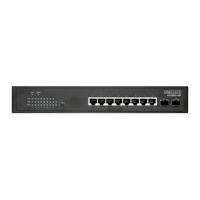Chapter 17
| Spanning Tree Commands
– 453 –
wide-scale disruption when a bridge node in a single instance fails, and
allowing for faster convergence of a new topology for the failed instance.
◆ By default all VLANs are assigned to the Internal Spanning Tree (MSTI 0) that
connects all bridges and LANs within the MST region. This switch supports up
to 33 instances. You should try to group VLANs which cover the same general
area of your network. However, remember that you must configure all bridges
within the same MSTI Region (page 453) with the same set of instances, and the
same instance (on each bridge) with the same set of VLANs. Also, note that
RSTP treats each MSTI region as a single node, connecting all regions to the
Common Spanning Tree.
Example
Console(config-mstp)#mst 1 vlan 2-5
Console(config-mstp)#
name This command configures the name for the multiple spanning tree region in which
this switch is located. Use the no form to clear the name.
Syntax
name name
name - Name of the spanning tree.
Default Setting
Switch’s MAC address
Command Mode
MST Configuration
Command Usage
The MST region name and revision number (page 454) are used to designate a
unique MST region. A bridge (i.e., spanning-tree compliant device such as this
switch) can only belong to one MST region. And all bridges in the same region must
be configured with the same MST instances.
Example
Console(config-mstp)#name R&D
Console(config-mstp)#
Related Commands
revision (454)

